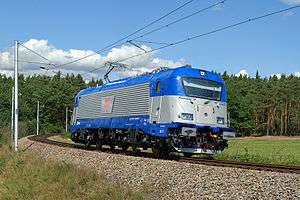ČD Class 380
The Class 380 is a tri-voltage electric locomotive manufactured by Škoda for Czech railways České dráhy.
| ČD Class 380 | |||||||||||||||||||||||||||||||||
|---|---|---|---|---|---|---|---|---|---|---|---|---|---|---|---|---|---|---|---|---|---|---|---|---|---|---|---|---|---|---|---|---|---|
 380 002-6 on test at Cerhenice | |||||||||||||||||||||||||||||||||
| |||||||||||||||||||||||||||||||||
| |||||||||||||||||||||||||||||||||
| |||||||||||||||||||||||||||||||||
| |||||||||||||||||||||||||||||||||
History
The Class 380 is Škoda's entry into the modern electric locomotive market. Internally designated Type 109E, the locomotives were originally conceived in 2004 and designed for operation in Austria, Germany, Hungary, Poland and Slovakia as well as the Czech Republic. The 109E Škoda has a top speed of 200 km/h and is compatible with both AC and DC catenaries, as is expected of current multisystem locomotives.[1] The locomotives are equipped to work on three electrification systems: 3 kV DC, 25 kV 50 Hz AC and 15 kV 16.7 Hz AC, drawing power from overhead lines.[2]
In 2005 České dráhy (ČD) ordered 20 locomotives with delivery in 2009 and certifications for service in all of the above-mentioned countries. The first locomotive was not delivered until 2010 and lacked any national service certification (only trial service certification for the Czech Republic). As a result, České dráhy refused to accept the locomotives.[3]
In April 2013 the locomotive received the TSI certificate and in 2015 an arbitration court ruled on the protracted dispute between ČD and Škoda Transportation regarding the late delivery of the locomotives[4]. While the German railway authority granted approval for the locomotives at up to 200km/h in Germany[5], their planned use on the Prague - Dresden - Berlin - Hamburg route never happened, with ČD choosing to lease Siemens Vectron locomotives instead[6].
Orders of similar locomotives
Despite the problems with the approval of CD locomotives, in 2013 Deutsche Bahn signed a contract with Skoda for 6 locomotives of 109E type[7], designated Class 102 in Germany. The contract was also for push-pull carriages to be deployed with the locomotives on RegionalExpress services on the Munich - Nuremberg High Speed Line. TSI Certification was granted for the trains in November 2018, almost two years after the expected start of service with the trains, with the expectation of services beginning in 2019[8].
See also
| Wikimedia Commons has media related to CZ Class 380. |
References
- "RAILCOLOR.NET - modern locomotive power - Skoda 109E". railcolor.net. Retrieved 30 August 2010.
- "Lokomotiva 109 E". JPB. Retrieved 30 August 2010.
- Šindelář, Jan. "Nová škodovácká lokomotiva konečně získala evropský certifikát". 18 April 2013 (in Czech). Archived from the original on 12 December 2018. Retrieved 12 December 2018.
- ČD loses Škoda Transportation locomotive battle
- Škoda 109E approved for use in Germany
- ČD leases ELL Vectrons for Hamburg – Praha route
- DB signs contract for Škoda Transportation push-pull trains
- TSI certification for Škoda Transportation push-pull trainsets
External links
- Locomotive 109 E (ČD) on Skoda Transportation site (in English)
- Locomotive 109 E (ZSSK) on Skoda Transportation site } (in English)
- Comprehensive fansite (in Czech)